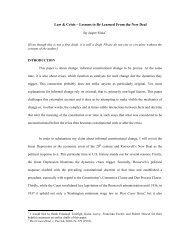In Search of an Enforceable Medical Malpractice Exculpatory
In Search of an Enforceable Medical Malpractice Exculpatory
In Search of an Enforceable Medical Malpractice Exculpatory
You also want an ePaper? Increase the reach of your titles
YUMPU automatically turns print PDFs into web optimized ePapers that Google loves.
June 2009] MEDICAL MALPRACTICE EXCULPATORY AGREEMENTS 861<br />
healthcare, <strong>an</strong>d they certainly need not affect the quality <strong>of</strong> care for<br />
the less affluent. 51 Even assuming that the malpractice system plays<br />
the role it is traditionally thought to in ensuring quality, to the extent<br />
that “quality” is not a treatment-by-treatment decision <strong>an</strong>d at least<br />
some patients choose to retain the possibility <strong>of</strong> suing for malpractice,<br />
<strong>an</strong> incentive for the doctor to meet the malpractice st<strong>an</strong>dard<br />
remains. 52 Furthermore, informed patients might refuse to sign contracts<br />
that negatively affect quality. 53<br />
The second prong <strong>of</strong> the Ash rule draws upon concerns that<br />
healthcare providers could abuse their “special relationship” with<br />
their patients. 54 The Ash court gave two different justifications for the<br />
special-relationship prong. At the time Ash was written, a prominent<br />
contracts treatise—speaking <strong>of</strong> the use <strong>of</strong> “special relationships” to<br />
invalidate exculpatory agreements generally—explained that there<br />
were multiple “bases for deciding that a bargain, otherwise valid,<br />
which exempts one from future liability to <strong>an</strong>other that would arise<br />
except for the bargain is invalid because the parties are in a certain<br />
relationship to each other.” 55 One basis was that “a relation <strong>of</strong>ten<br />
represents a situation in which the parties have not equal bargaining<br />
51 See PAUL C. WEILER, MEDICAL MALPRACTICE ON TRIAL 6 (1991) (arguing physici<strong>an</strong>s<br />
view malpractice judgments as accidents—not as evidence <strong>of</strong> quality); Richard A.<br />
Epstein & Al<strong>an</strong> O. Sykes, The Assault on M<strong>an</strong>aged Care: Vicarious Liability, ERISA Preemption,<br />
<strong>an</strong>d Class Actions, 30 J. LEGAL STUD. 625, 642 (2001) (claiming malpractice liability<br />
is essentially r<strong>an</strong>dom); Stephen D. Sugarm<strong>an</strong>, Doctor No, 58 U. CHI. L. REV. 1499,<br />
1500–02, 1504 (1991) (reviewing WEILER, supra) (noting that very small fraction <strong>of</strong> those<br />
harmed by malpractice actually bring suit); Lori L. Darling, Note, The Applicability <strong>of</strong><br />
Experience Rating to <strong>Medical</strong> <strong>Malpractice</strong> <strong>In</strong>sur<strong>an</strong>ce, 38 CASE W. RES. L. REV. 255, 259–62<br />
(1987) (arguing malpractice premiums are not connected to quality). But see Jennifer<br />
Arlen & W. Bentley MacLeod, <strong>Malpractice</strong> Liability for Physici<strong>an</strong>s <strong>an</strong>d M<strong>an</strong>aged Care<br />
Org<strong>an</strong>izations, 78 N.Y.U. L. REV. 1929, 1940 n.36 (2003) (arguing Weiler study’s sample<br />
size was too small to draw statistically signific<strong>an</strong>t conclusion that malpractice liability is<br />
r<strong>an</strong>dom).<br />
52 See, e.g., LAW & POLAN, supra note 1, at 18–19, 61–62, 251–52 nn.18–19 (claiming<br />
quality <strong>of</strong> healthcare outcomes is largely influenced by unnecessary treatment); Mark R.<br />
Chassin et al., Does <strong>In</strong>appropriate Use Explain Geographic Variations in the Use <strong>of</strong> Health<br />
Care Services?, 258 J. AM. MED. ASS’N 2533, 2536 (1987) (arguing that seventeen to thirtytwo<br />
percent <strong>of</strong> studied procedures were unnecessary).<br />
53 <strong>In</strong>deed, it seems unlikely that patients would willingly sign contracts that give them<br />
reduced-quality care if they had the me<strong>an</strong>ingful option <strong>of</strong> paying for the higher-quality<br />
care, since “[p]atients generally w<strong>an</strong>t high quality at reduced costs, not cut rates with fewer<br />
protections.” Sylvia A. Law, A Consumer Perspective on <strong>Medical</strong> <strong>Malpractice</strong>, LAW &<br />
CONTEMP. PROBS., Spring 1986, at 305, 317. Even if a voluntary exculpatory agreement did<br />
affect quality, the Ash court’s concern was with a departure from the minimal st<strong>an</strong>dard <strong>of</strong><br />
care for less affluent patients who could not afford otherwise, Ash, 564 N.Y.S.2d at 311,<br />
<strong>an</strong>d a doctor might provide evidence that the patient had the fin<strong>an</strong>cial wherewithal to pay<br />
the higher fee <strong>an</strong>d not sign.<br />
54 Ash, 564 N.Y.S.2d at 310–11.<br />
55 15 SAMUEL WILLISTON & WALTER H. E. JAEGER, A TREATISE ON THE LAW OF<br />
CONTRACTS § 1751 (3d ed. 1972).
















